Deep Autumn is warm and dark and shares characteristics with autumn and winter in the 12 season system of color analysis.
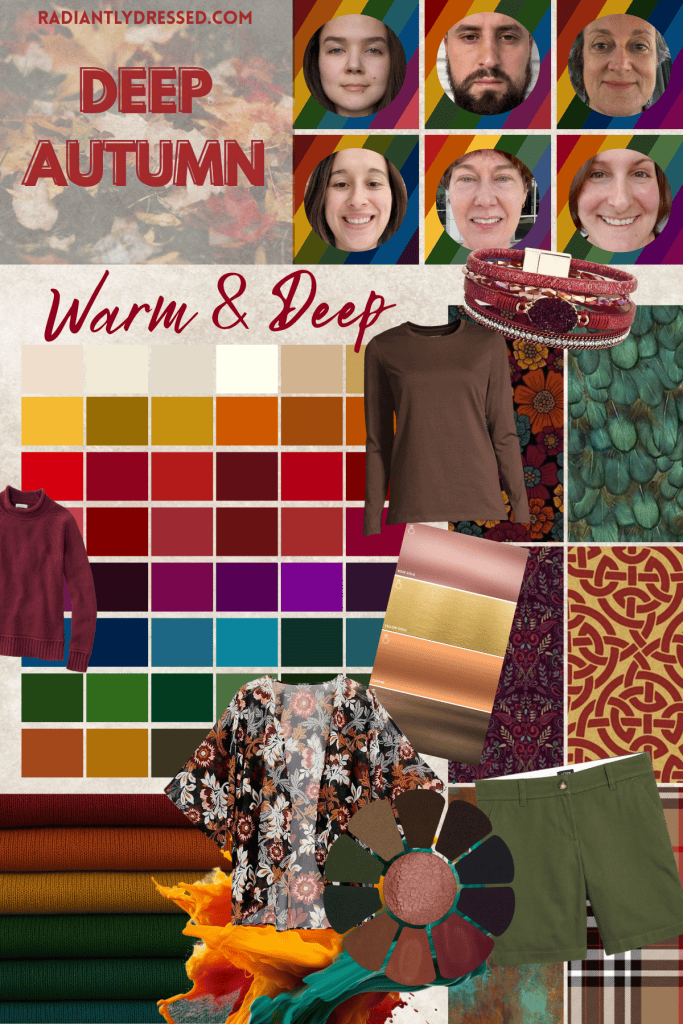
Deep Autumn is a unique blend that marries the warm, rich hues of autumn with the dark, intense shades of winter, according to the 12-season system of color analysis.
Are you captivated by the rich, dark colors that emerge when autumn begins its transition into winter? Do the deep reds of changing maples, the complex browns of decomposing leaves, and the mysterious teal of dwindling daylight resonate with you?
If these colors not only catch your eye but also seem to amplify your natural beauty, you’re likely a deep autumn.
The is a comprehensive guide to deep autumn in the 12 season system of color analysis. Keep reading to learn the physical characteristics, best makeup, a color palette, wardrobe staples for deep autumn, and how to create your own custom palette.
Table of Contents
The 12 Seasons of Color Analysis
Seasonal color analysis is a transformative approach that helps you discover which colors make you look and feel your best. By examining the undertones of your skin, eyes, and hair, this system categorizes you into one of the 12 distinct color families.
The result? A curated palette that enhances your natural beauty and instills a newfound sense of confidence.
In the realm of seasonal color analysis, we examine the three key elements of your appearance: skin, eyes, and hair, to identify a color family that best complements you. The six primary components we consider are warm, cool, deep, light, soft, and bright.
The autumn color family is predominantly warm, and it encompasses three distinct types including soft autumn, true/warm autumn, and deep autumn.
- Soft Autumn
- True/Warm Autumn
- Deep Autumn (you are here)
In this guide, we delve into the rich, complex beauty of Deep Autumn, a unique blend that captures both the warmth of autumnal shades and the depth of wintry hues.
This site contains affiliate links. As an Amazon associate I earn from qualifying purchases. Thank you for your support!
Am I a Deep Autumn?
Do people often comment on how rich or intense your coloring is, even if they can’t quite put their finger on why? If your hair and eyes are noticeably dark and your overall coloring carries richness and warmth, you might be a Deep Autumn.
Look closely at your eyes. Regardless of their overall color, you’ll likely notice elements of green, brown, or gold peeking through. There’s an earthy intensity there that feels grounded, even mysterious.
When you wear black, you may get away with it… but something feels slightly off. It can come across as just a bit too harsh, especially compared to the rich, warm tones that seem to light you up from within.
People tend to compliment you when you’re wearing bold, saturated autumn shades like olive, mustard, or rust. These tones not only look beautiful on you; they bring out your energy and confidence in a way that feels effortless.
If you find yourself avoiding cool pastels or icy blues like the plague (unless you’re in a bridal party), that’s another clue. As a Deep Autumn, you’re naturally drawn to rich, warm hues — and now you know why.
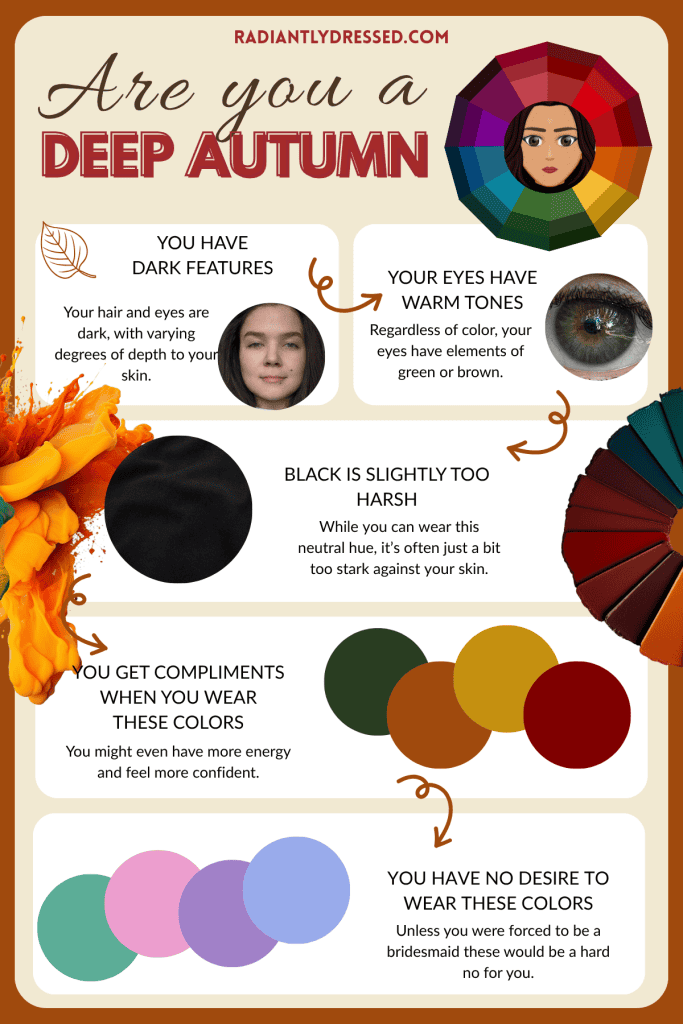
Still not sure? Try our AI Style Lab to get stylist inspired prompts to find your season, plus a community to explore your personal style.

You might also be ….
Deep Autumn is Dark and Warm
Deep Autumn is classified in the following ways: warm hue, dark value, neutral chroma.
- Warm hue – the undertone is always red, but various overtones of gray or violet may give a cooler or occasional blue appearance, causing confusion when determining the difference between deep autumn and deep winter.
- Dark value – this is one of the seasons characterized by depth and darkness of color. This is one of the defining characteristics and holds true for all deep autumns.
- Neutral chroma – there is some variation here. Some deep autumn types may exhibit much more muting as seen in the need for grayer toned colors, while others may be able to handle more brightness.
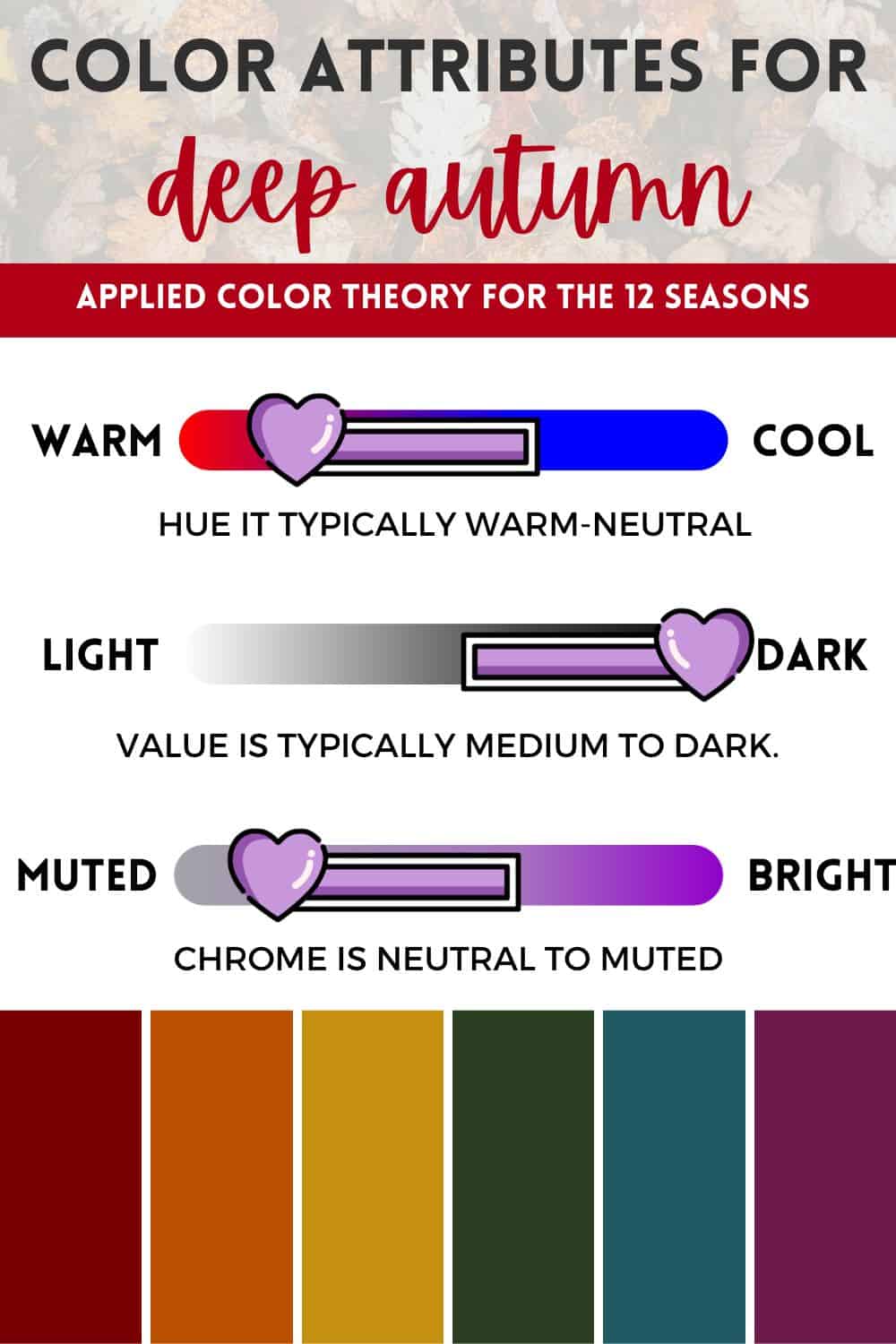
Want to save these graphics for quick access later?
Download the Deep Autumn Starter Kit to get the color images featured in this post. You’ll also get a bonus FREE color palette template to make your own colorful closet plan.
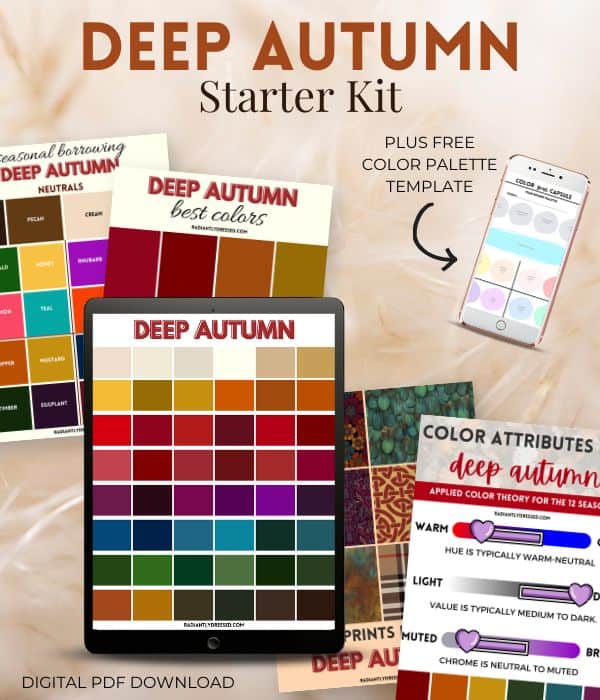
The hint of warmth we identify is mainly noticeable in the skin, but also subtly present in the eyes. Unlike True Warm Autumn, Deep Autumn leans more neutral, especially as it shares characteristics with its sister season, Deep Winter.
Deep autumn eyes are typically brown, hazel, or green. Some individuals may also have a gray-brown mix, giving their eyes a muddy appearance.
While hair color is a less essential feature in determining one’s seasonal palette, it often serves as a complementary trait in Deep Autumn types. The hair is dark – brown or black – with hints of mahogany, red, auburn, or gold.
The overall appearance is low/medium contrast, rich brown tones upon each other. Lighter shades of caramel or gray may exist as well.
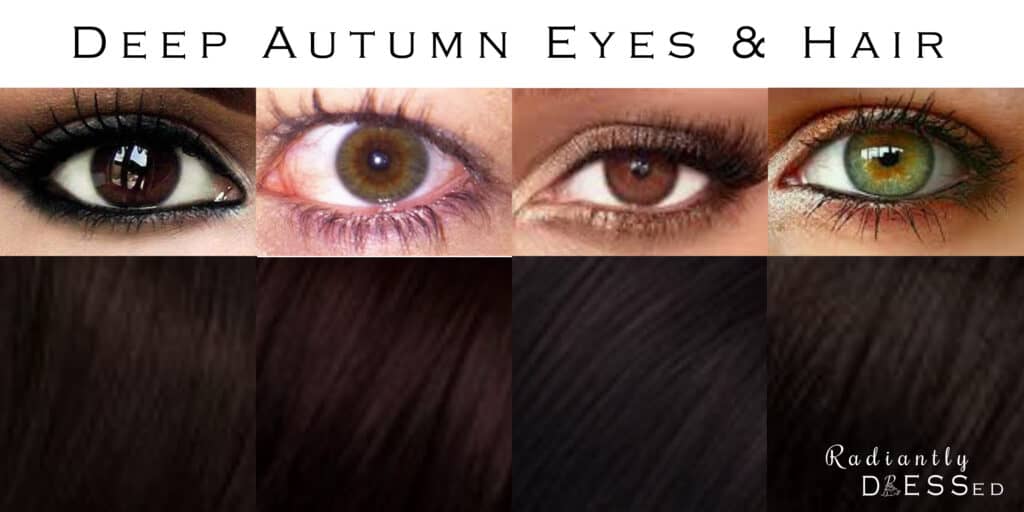
Deep Autumn shares a unique trait with its sister season, Deep Winter: both are characterized by darker values. While Deep Autumn can embrace somewhat richer colors due to its proximity to Deep Winter, it’s essential to maintain a low overall contrast level to align with its own characteristics of neutral to slightly muted chroma and medium-to-dark value.
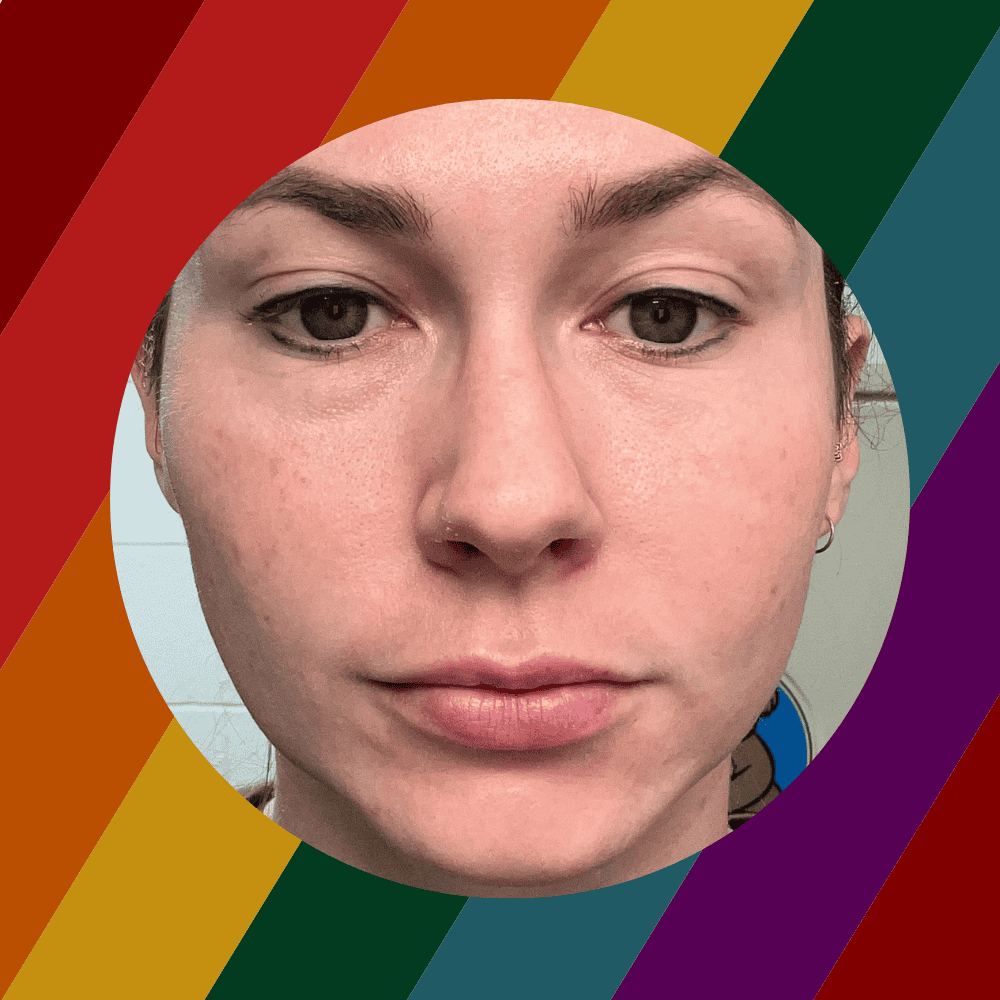






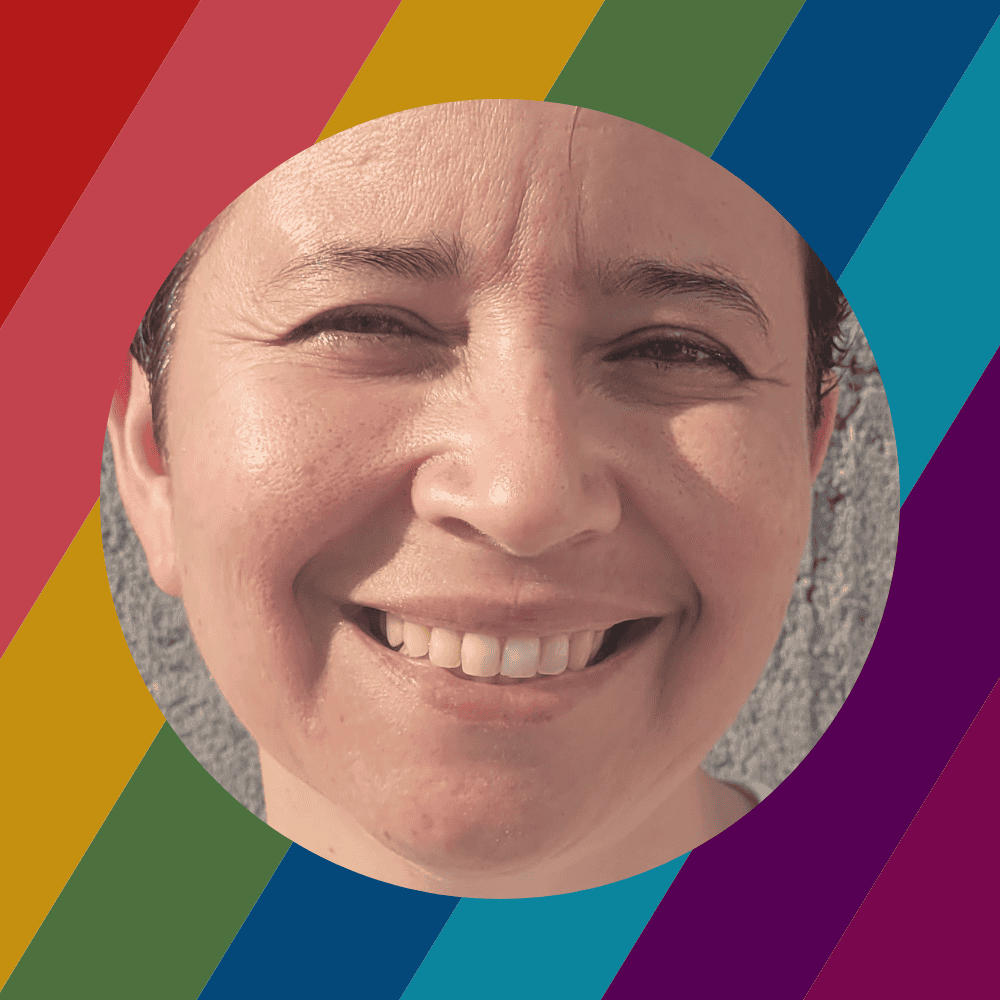
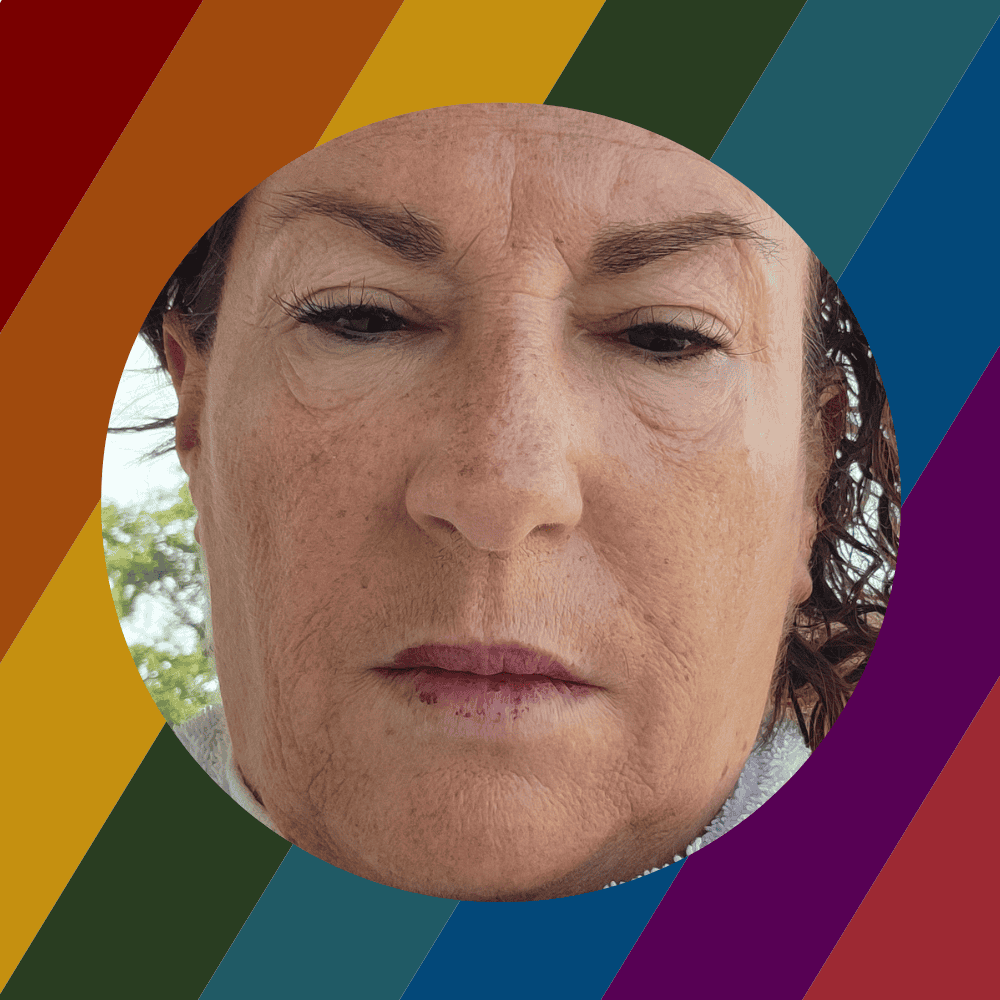



Deep Autumn Color Palette
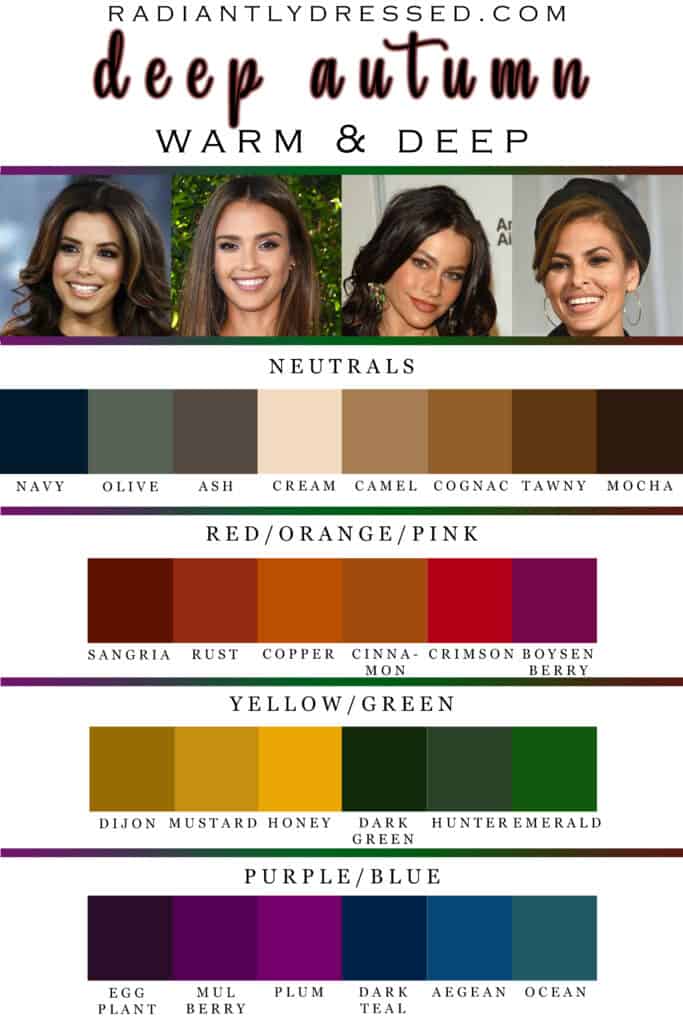
In the world of Deep Autumn, traditional neutrals like black and white take a back seat. Instead, the wardrobe thrives on the richness of browns and navies, and cream rises as the new white.
Olive and camel serve as the colored neutrals, seamlessly blending into the canvas of a Deep Autumn’s clothing ensemble.
When it comes to warm colors, reds and oranges dominate, adding a splash of vitality. But don’t overlook shades like boysenberry—a warm pink that holds its own against the season’s fiery tones.
Yellows, meanwhile, borrow their hues from culinary delights like Dijon mustard and warm honey, rounding out the warmer end of the spectrum.
For those who love green, Deep Autumn offers a range of dark, forest-inspired shades that evoke the richness of nature.
Blues, often a tricky color for this palette, become wearable with a dash of green, effectively warming them up.
Purples that lean toward the red end of the spectrum best complement the Deep Autumn skin tone, creating a harmonious visual impact.

Want to save these graphics for quick access later?
Download the Deep Autumn Starter Kit to get the color images featured in this post. You’ll also get a bonus FREE color palette template to make your own colorful closet plan.

While every color family has a variant that can work for a Deep Autumn, some shades are easier to incorporate than others. For instance, warm pinks might shift into deeper corals, while some reds and blues may require adjustments to better suit your season.
It’s crucial to avoid blacks, whites, and pastels, as they don’t align with the warm and muted characteristics of Deep Autumn.
Aim for colors that offer a balanced match to your natural chroma—neither overly vibrant nor overly muted. This ensures a harmonious look that complements Deep Autumn’s unique features.
Deep Autumn Colors for the Whole Year
When borrowing from other seasons, it’s helpful to consider those which share attributes.
Many women like to choose colors that help them feel in touch with the calendar season, like bright green in the spring.
For Deep Autumn, the following borrowing recommendations work across the whole year.
In Spring, borrow colors from warm autumn to embody the brightness of spring.
In Summer, borrow colors from soft autumn to get a lighter, summery feel to your wardrobe.
In Fall, wear any colors from the 3 autumn seasons.
In Winter, borrow from deep winter to get the icy richness of the cold air.

Want to save these graphics for quick access later?
Download the Deep Autumn Starter Kit to get the color images featured in this post. You’ll also get a bonus FREE color palette template to make your own colorful closet plan.

Deep Autumn Color Combinations
There’s something really grounded and rich about Deep Autumn colors. They carry a natural confidence – like you didn’t have to try too hard because everything just works. And when you pair them together thoughtfully, that effortless beauty shines even more.
Let’s start with almond, seaweed, and aegean. This combo feels earthy, cozy, and a little unexpected. Almond keeps things soft, seaweed adds that moody depth, and aegean brings in just enough cool contrast. Perfect for a layered outfit on a crisp day, whether you’re running errands or heading to a casual dinner.
Copper and bistro are made for each other. These warm, toasty shades look so polished together, especially in textures like knits or leather. Picture a bistro-colored sweater with copper jewelry, or even the reverse: a copper top under a structured bistro blazer. It’s a great combo for feeling pulled together but still like you.
Then we’ve got cognac and plum, which is such a deep, delicious pairing. Cognac brings the earthy warmth, while plum adds a little drama. Try a plum dress with cognac boots or a bag. It’s a look that says “I know who I am,” without being flashy.
Last up is burgundy, eggshell, and caramel, a trio that’s effortlessly elegant. Eggshell keeps things light and fresh, while burgundy and caramel do the heavy lifting with depth and richness. It’s a beautiful palette for holiday events, brunches, or anytime you want to feel just a little extra put-together.
These combos are just a starting point. The best part? You can mix and match them in ways that feel completely authentic and totally flattering.
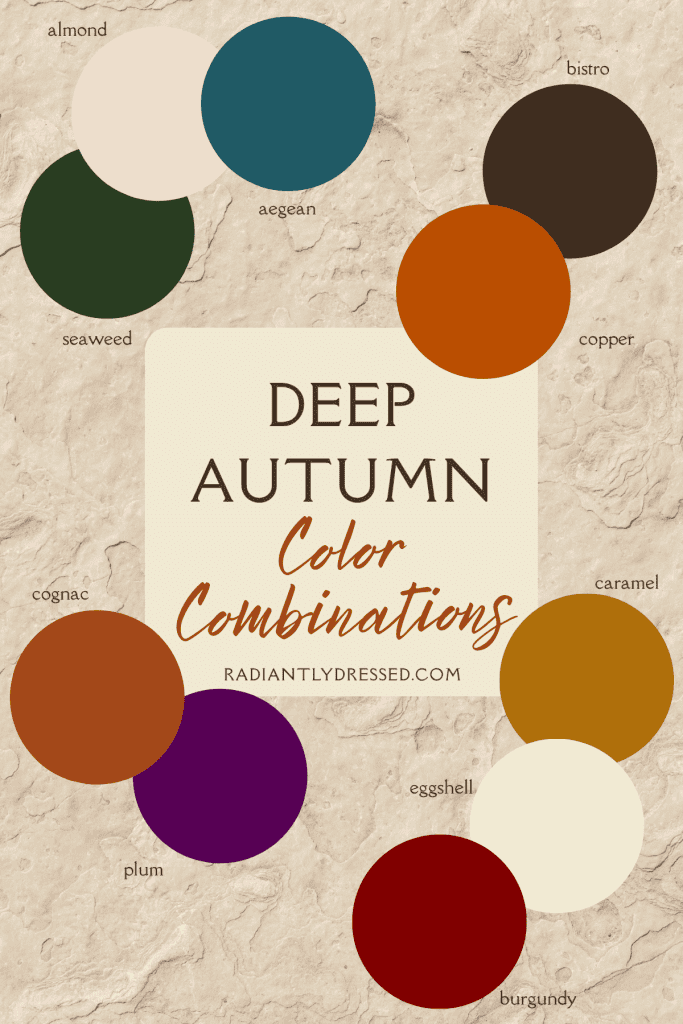
Choosing Prints for Deep Autumn
Choosing the right prints can add an extra layer of sophistication and personality to your Deep Autumn wardrobe. But not all prints are created equal for this color season. Here are some guidelines to help you make the most informed choices:
- Color Composition: Aim for prints that have less than 10% of colors outside your Deep Autumn palette. This ensures that the print complements your natural coloring.
- Scale: Medium to large-scale prints work best for Deep Autumn. Smaller prints can become too busy and detract from the richness of your natural hues.
- Contrast Level: Stick with prints that have a low level of contrast. High contrast patterns can overwhelm your features and disrupt the overall harmony of your look.
- Value: Opt for prints with a darker value to align with the overall depth of the Deep Autumn color spectrum.
By keeping these factors in mind, you’ll be better equipped to select prints that not only align with your color palette but also enhance your natural beauty and personal style. And don’t forget, the most important factor is how you feel in these prints.
Confidence shines through, no matter what you’re wearing.
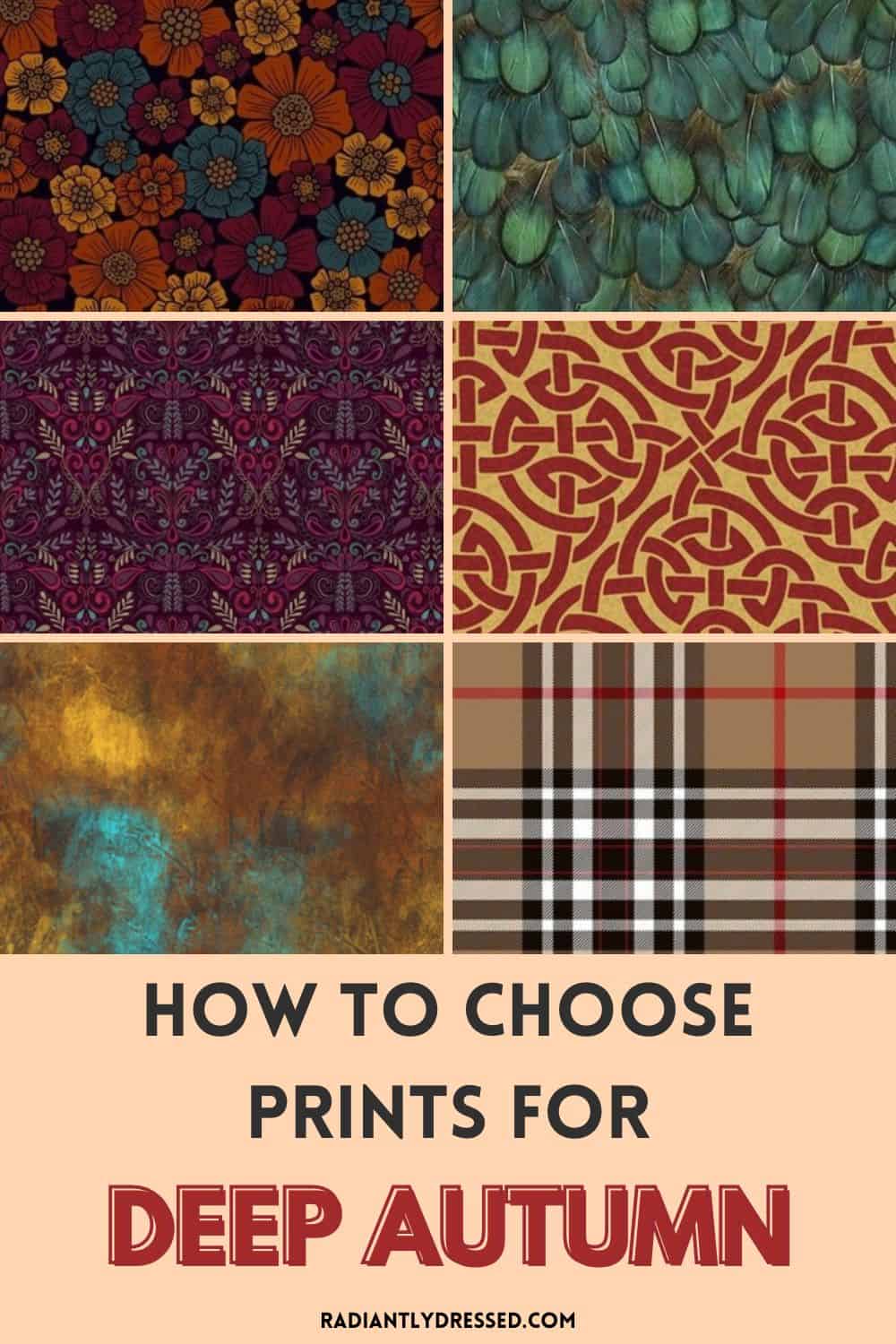
Wardrobe Essentials for Deep and Warm Coloring
When putting together outfits, low contrast options featuring mostly darker colors in the palette will be best. Using light neutrals is still a suitable outfit, however.
Patterns should feature mostly dark colors with a hint of light, such as traditional leopard.
When choosing other patterns such as florals, plaids, and stripes, look for options that have a dark background with smaller elements as contrast.
Dark wash denim is preferred over medium and light wash. Leather should be in the brown family, like mocha or cognac.
Yellow and rose gold are great metals for deep autumn.

Click here to shop the Deep Autumn wardrobe essentials.
How Do I Build a Deep Autumn Capsule Wardrobe?
To build a Deep Autumn capsule wardrobe, start with key neutral staples that align with your season’s characteristics. For Deep Autumn, good choices include dark brown, navy, olive, and camel. Consider having essential items like pants, skirts, and jackets in these neutrals.
Next, incorporate your main color and 2-3 accent colors. You might choose a warm red, a deep orange, or a dark mustard as your main color, and then pick accent colors that can be easily mixed and matched with your main and neutral colors.
Here’s a simple guide to create a color palette include:
- Base Colors: Black (if you still want to include black)
- Dark Neutral: Dark brown or Navy
- Light Neutral: Cream or Camel
- Main Color: Deep red or Mustard
- Accent Colors: Pick 2-3 from your palette, like deep teal, burgundy, or warm purple
Deep Autumn Outfit Ideas
When you’re building outfits as a Deep Autumn, wearing the right colors is just the start. What’s more important is combining them in ways that feel rich, layered, and totally in sync with your natural depth. These four outfit formulas do just that, blending warmth and grounded elegance with just the right pop of color or texture to make things interesting.
Outfit 1 leans casual with an earthy twist. Tan tailored shorts and an espresso tee create an easy foundation, but it’s the accessories that steal the show. A peacock-colored sandal and coordinating bag add depth and a bit of unexpected vibrance, while the printed boho bag ties it all together with its blend of earthy hues. The earrings echo the outfit’s natural vibe. It’s the kind of look you’d wear on a summer stroll through the farmer’s market or a relaxed lunch with friends.
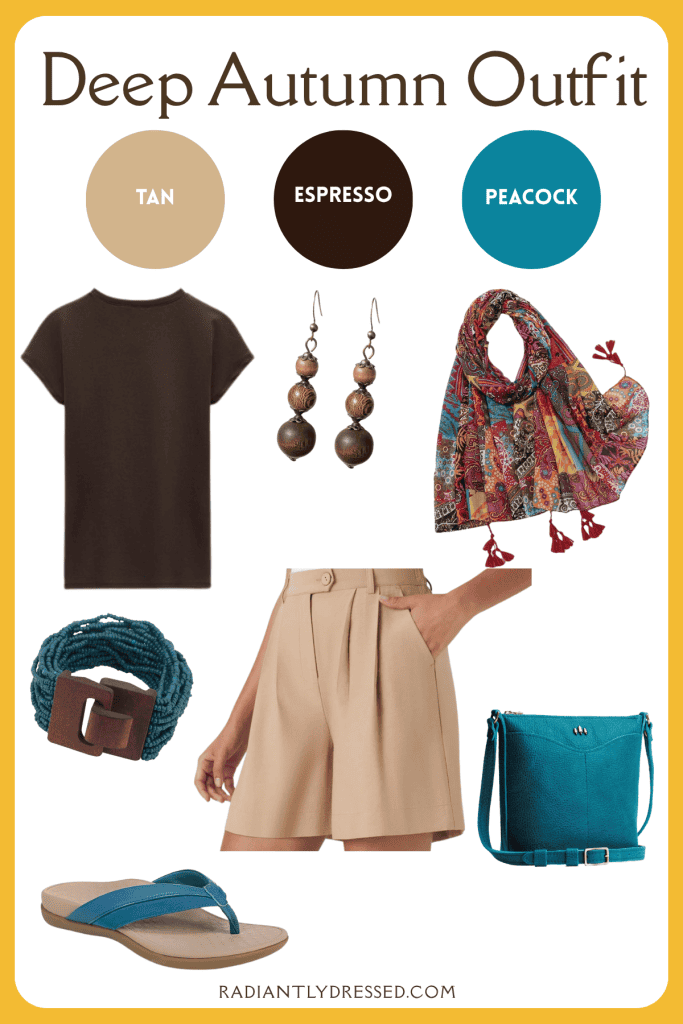
Outfit 2 is breezy yet polished. A honey-hued maxi skirt moves effortlessly and pairs beautifully with a lightweight long-sleeve top in a botanical print of basil and honey, with soft hints of pink. A matching honey vest adds structure, and the basil green sandals and statement earrings lend a refined, coordinated touch. The eggshell handbag balances the palette perfectly. This look could easily take you from a gallery afternoon to an outdoor concert on a warm evening.
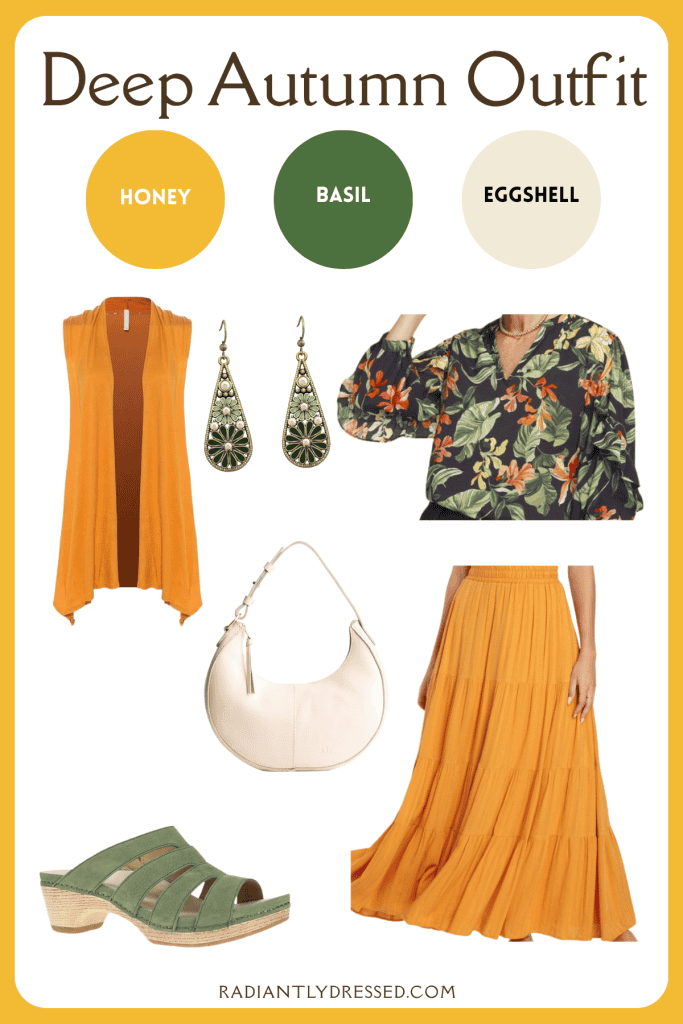
Outfit 3 gives off subtle drama in all the best ways. Cognac trousers and a printed cognac tee are grounded and warm, while the boysenberry cardigan draped overtop introduces rich contrast. Add a persimmon crossbody bag and stained-glass-style earrings in all three colors, and you’ve got a perfectly harmonized fall look. This outfit is ideal for workdays that flow into casual dinner plans; it’s polished but not too buttoned-up.
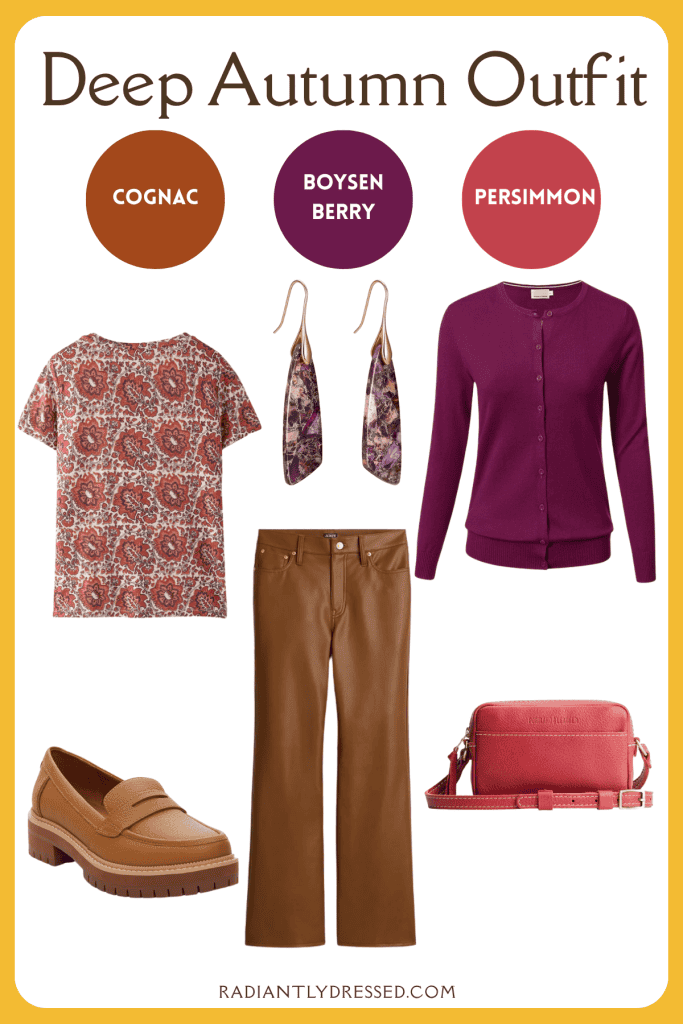
Outfit 4 is bold, grounded, and made for cooler days. Seaweed trousers and matching boots give this look structure, while a maroon sweater and coordinating shawl bring a hit of saturated color. The caramel tote softens the mood just a bit, and maroon-and-gold stud earrings echo the warm richness of the palette. The circular pendant necklace adds just the right amount of shine. This look feels right at home on a crisp day, maybe a weekend brunch, or even a cozy night out.
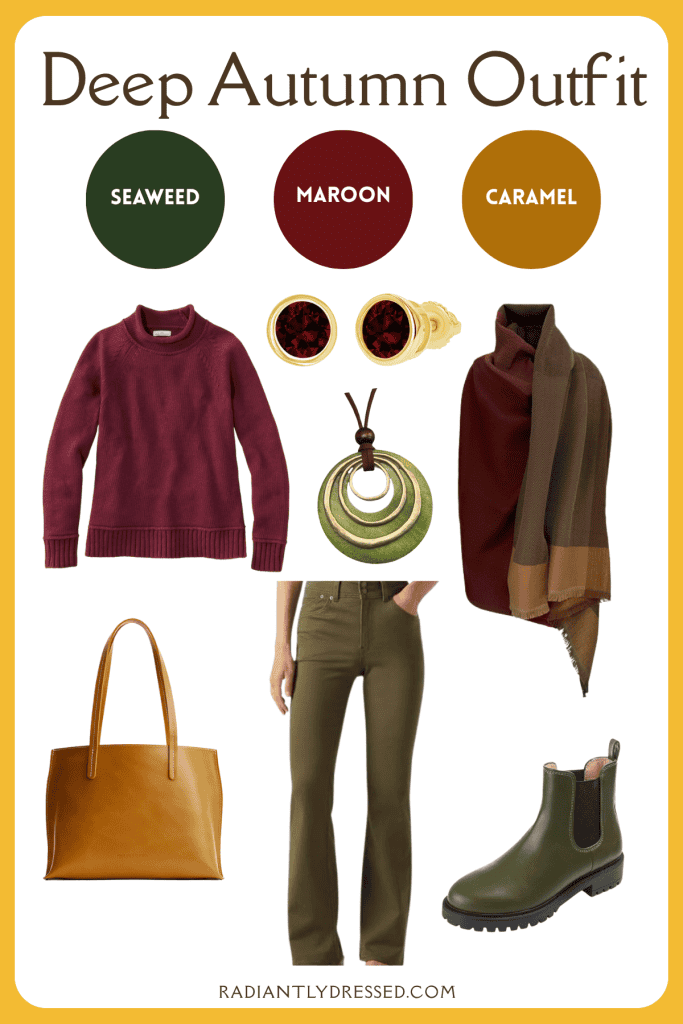
Makeup for the Deep Autumn Woman
To truly accentuate the deep autumn features, your makeup palette should harmonize with your natural warmth and depth.
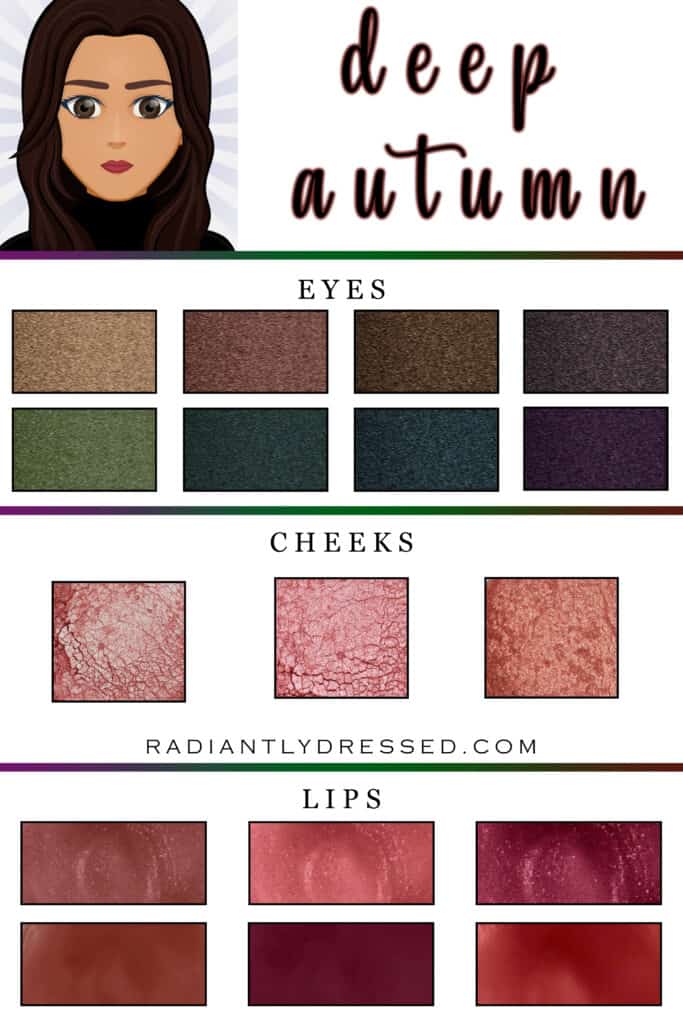
For the eyes, choose medium and dark brown neutrals. When you’re in the mood for a pop of color reach for olive green, forest green, deep teal, and dark purple.
To flatter your warm, dark skin, choose blushes in rich shades of coral, peach. These colors don’t just complement; they enhance.
Forget the idea of a nude lip; it won’t do justice to your deep autumn characteristics. Instead, consider a caramel shade as your go-to neutral lip color.
If you’re in the mood for something bolder, the darkest warm shades wine, raisin, and espresso will serve you well.
Steer clear of any makeup colors that lean towards cool tones. Pink or berry red lipsticks, cool blue and green eyeshadows, and soft pink blushes are not your friends.
This makeup advice aligns with your natural coloring, allowing you to emphasize what makes you uniquely ‘Deep Autumn.'”
Inspiration for Deep Autumn: A Palette of Depth and Warmth
Deep Autumn revels in a tapestry of rich, intense colors. Think chocolate brown, ripe aubergine, forest green, deep mustard, pumpkin, wine, and midnight teal. These are the shades that illuminate the beauty of a Deep Autumn woman.
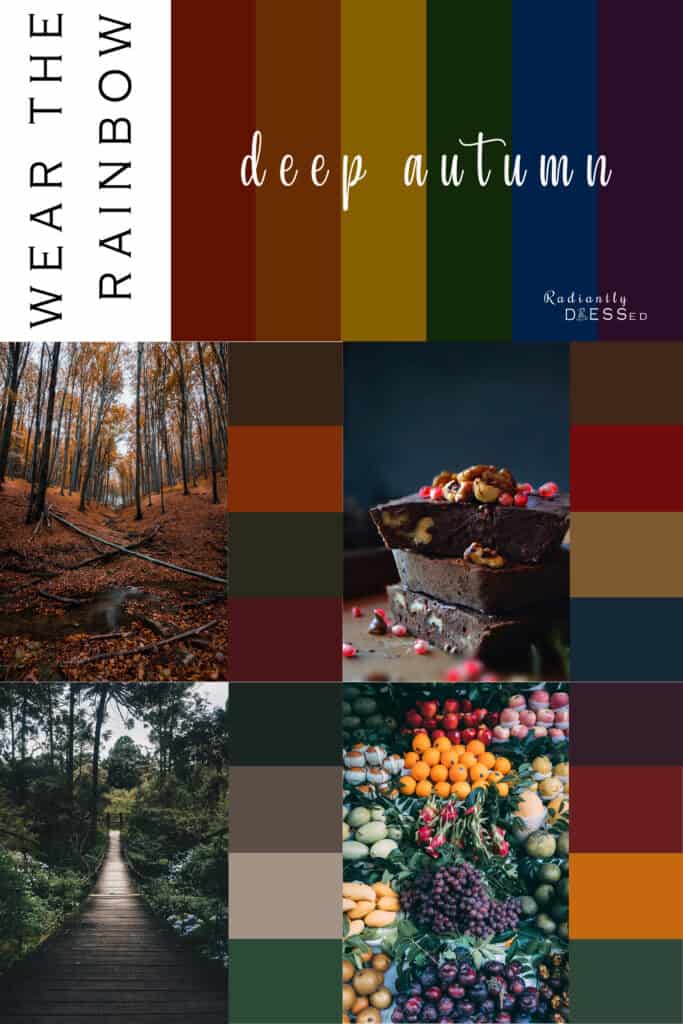
Here we see some different elements where deep autumn is naturally found. The 6 color rainbow depicts the truest, most neutral form of colors, but the deep autumn rainbow is warmer and greatly shaded.
Visual Inspiration
To truly visualize the Deep Autumn color spectrum, consider the following natural elements, each of which encapsulates the essence of this season:
- Autumn Forest: Deep oranges and reds from fallen leaves, accompanied by browns and dark olives from the surrounding trees.
- Evergreen Forest: A mixture of greens and brownish-grays that resonate with the Deep Autumn palette.
- Chocolate and Pomegranate: Rich browns with pops of pomegranate reds encapsulate indulgent and bold color choices.
- Harvest Vegetables: A spectrum from mustard yellow to plum purple, offering a rich variation in your palette.
By aligning your wardrobe with these inspirations, you can truly bring out the Deep Autumn in you.
Frequently Asked Questions about Deep Autumn
Is Deep Autumn the same as Dark Autumn?
Yes, they are the same thing. Both terms refer to the same color season characterized by a dark value and muted chroma, leaning towards warm undertones.
What is the difference between Deep Autumn and Deep Winter?
Deep Autumn and Dark Winter are sister palettes and can share some colors. However, their core differences lie in the temperature of the colors and the overall feel. Deep Autumn colors are warm and earthy, with a sense of coziness and richness. Dark Winter features cooler and more high-contrast shades, focusing on hues like wine red, royal blue, and charcoal gray. People with Deep Autumn coloring may find some Dark Winter colors flattering, but it’s important to prioritize warmth in their palette.
Which colors should Deep Autumn individuals avoid?
Deep autumn individuals should avoid overly cool, bright, or pastel colors, as these may not complement their natural warm undertones. Steer clear of colors that are too icy or light, such as cool grays, lavender, and pale blue. Instead, opt for the warm and dark colors that flatter your deep autumn palette.
What are some outfit ideas for Deep Autumn colors?
When building an outfit with deep autumn colors, focus on combining warm and dark shades to create a rich and harmonious look. You can start with a base of dark red, deep teal, or rich brown, and then add complementary colors and accents to bring out the warmth and depth of your palette. For instance, pair a deep red blouse with dark brown trousers, or layer a warm-toned scarf over a deep teal jacket. Don’t be afraid to play with textures and patterns that enhance the cozy, autumnal feel of your deep autumn outfits.
Can Deep Autumn wear red?
Yes, Deep Autumn can certainly wear red, especially if it leans on the warm side. Think in terms of rich, deep reds like brick or crimson rather than bright, fiery reds. These deeper reds complement the warm and dark aspects of the Deep Autumn palette.
Can deep autumn wear burgundy?
Absolutely, burgundy is an excellent choice for Deep Autumn. It aligns well with the dark value and slightly muted chroma characteristics of this season. Burgundy can serve as a rich, versatile neutral or as a statement color in your wardrobe.
Can deep autumn wear pink?
Yes, but opt for warm and deep shades of pink like coral or boysenberry. Light, pastel pinks may not be as flattering because they can wash out the deep, warm tones that characterize Deep Autumn.
Can I still wear black?
Of COURSE you can still wear black. I personally believe that black is a staple in any wardrobe. Any season can wear black, but some may find it is overwhelming. Fortunately as a deep autumn that is less likely than someone who is a light season. Black isn’t your BEST color, however, as you’ll find dark brown and even dark navy are more flattering. However, if you are building a capsule wardrobe around dresses, I highly recommend using black as a base simply because you’ll be able to find items easier.
I hate these colors, could my season be wrong?
Yes absolutely, it could be true. But I want to challenge you, what is it that you hate? Is it the neutrals that you don’t like? Perhaps you don’t like brown? Refer back to my statements above about wearing black. Is it one of the color families, yellow or orange perhaps? Don’t wear them! Just because a palette includes all these colors doesn’t mean you should wear them all. I dare you to look at your closet and see if you naturally gravitate to any of these colors. If the answer is no, and you still feel this is completely wrong, let me know! I can help!
Can I only wear these colors?
Absolutely not! You should wear colors that make you feel confident and happy. That said, you may find that understanding your Deep Autumn season changes how you feel in certain hues. For example, if you’ve always wanted to wear pastel blue or pink, go ahead! Just know that these shades might not highlight your natural beauty the way deep autumn colors would. If you’re eager to experiment, consider looking into your sister seasons for more options.
Action Steps for Embracing Your Deep Autumn Color Palette
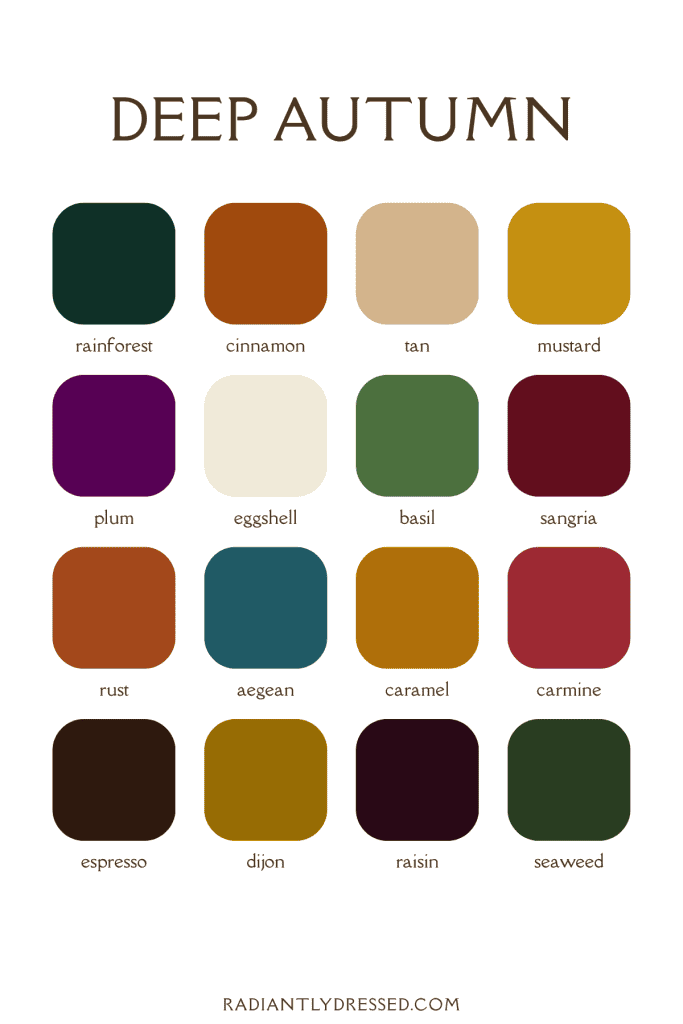
- Identify Your Colors: Start by familiarizing yourself with the Deep Autumn color palette. Keep it handy on your phone or print it out for quick reference when shopping.
- Purge Your Closet: Remove items that are far from your Deep Autumn colors or don’t make you feel good. Consider donating or reselling them.
- Invest in Neutrals: Buy wardrobe staples in your best neutral colors like espresso, camel, and cream. These will be the backbone of your wardrobe.
- Choose Your Best Colors: Pick 2-3 signature colors from your Deep Autumn palette that you love the most. These will give your capsule wardrobe some variety.
- Plan Your Capsule: Following the 100 Piece Wardrobe Framework, build a capsule wardrobe around your neutrals and accent colors. Aim for versatility and cohesiveness.
- Shop Smart: When shopping for new items, always have your palette in mind. This will save you both time and money in the long run.
- Trial and Adjust: Don’t be afraid to experiment a bit. Wear your new colors and pay attention to the compliments you receive and how you feel in them. Make adjustments as needed.
- Seek Guidance: If you’re struggling to implement your Deep Autumn palette, consider seeking professional help. A color analysis session can be a transformative experience.
- Celebrate You: Embrace your Deep Autumn qualities as a testament to the unique beauty God has bestowed upon you.
By following these steps, you’ll be well on your way to simplifying your wardrobe while looking your best, feeling confident, and honoring your uniqueness.
Final Thoughts on Deep Autumn
Deep Autumn is a season that blends richness and warmth with incredible intensity. Your palette is filled with saturated, grounded colors that reflect everything from the spice tones of a kitchen in autumn to the moody greens of a shadowed forest.
If you’ve ever felt like black was just a little too harsh or bright pinks overwhelmed your skin, discovering Deep Autumn can feel like finally coming home.
Deep Autumn color combinations like cognac and plum or almond, seaweed, and aegean don’t shout; they resonate. These tones support your natural features instead of competing with them, which is why Deep Autumns often light up when they wear their best colors.
The outfit ideas we explored are designed to show you how Deep Autumn can work in the real world. These aren’t fantasy runway looks; they’re pieces you could wear to brunch, to the office, or out for date night. They’re practical and beautiful, and they honor the natural depth and warmth that makes your coloring so unique.
Whether you’re standing in your closet wondering what to pack for a trip or choosing a dress for a special event, you’ll always feel more confident when you’re surrounded by colors that truly align with who you are. That’s the heart of seasonal color analysis: helping you feel more like yourself, more of the time.
If you’ve been resonating with Deep Autumn, consider this your permission slip to embrace it fully. You don’t have to trade boldness for harmony; you get to have both. Rich burgundies, golden browns, deep olives, and earthy teals are your allies now. And with just a little intentionality, your wardrobe can become a reflection of your quiet confidence and inner strength.
Are you a Deep Autumn? Let us know in the comments!
Related Color Analysis Articles:
- Soft Summer vs Soft Autumn
- Color Theory for Color Analysis
- Eye Patterns and Color Analysis
- Personality and Color Analysis
Deep Autumn sits on the cusp of autumn and winter and is warm and dark.
Stacey is the owner and creator behind Radiantly Dressed. She is a certified image consultant and AICI member focusing on creating simplicity in wardrobes via color and style.

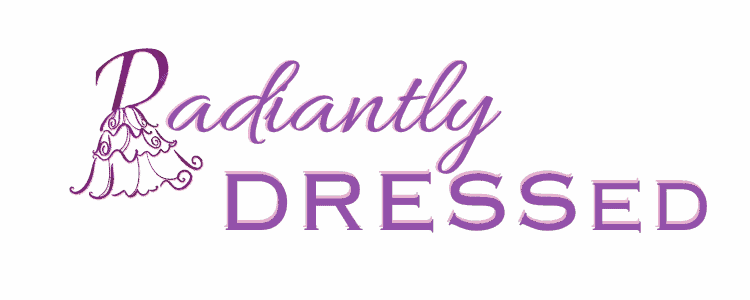
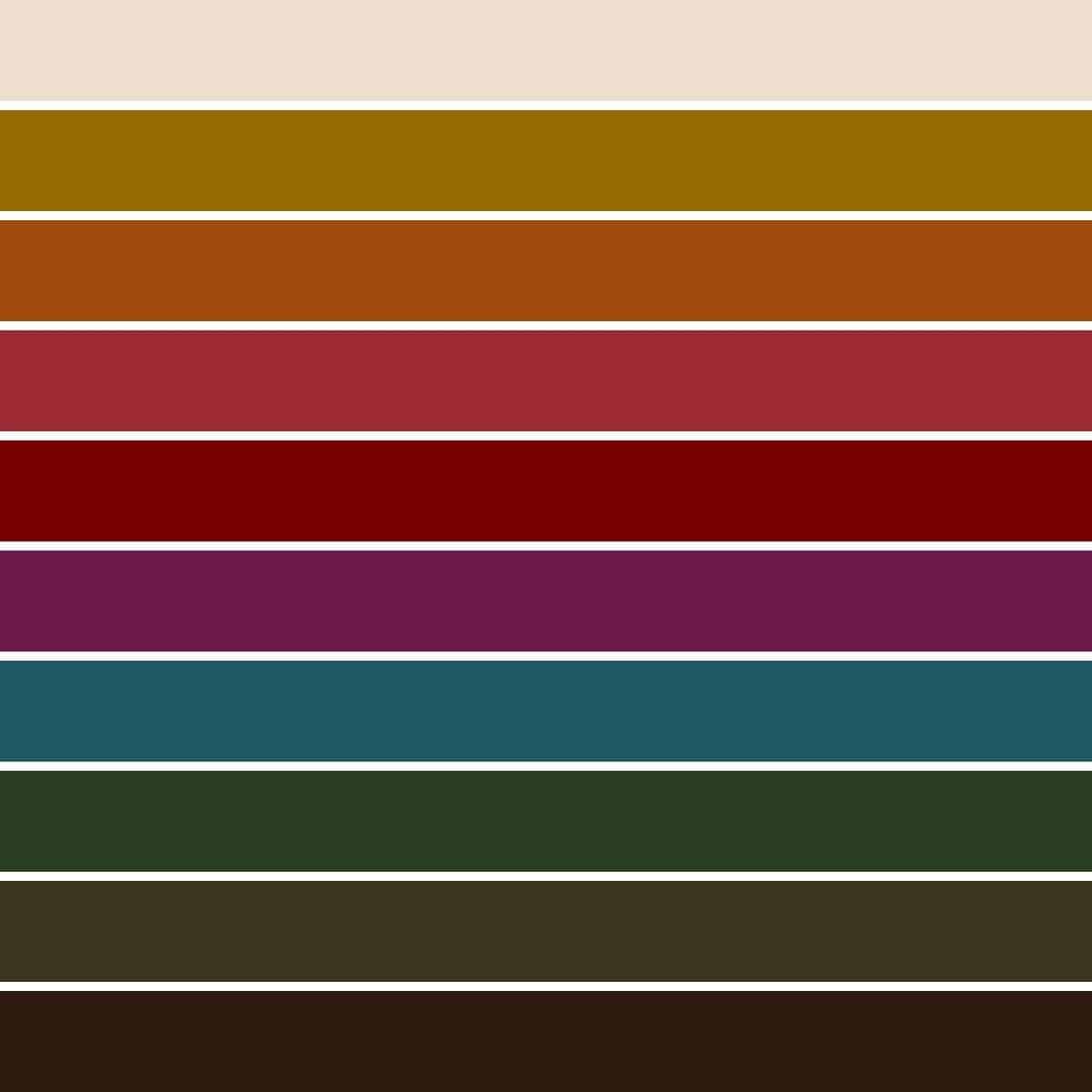
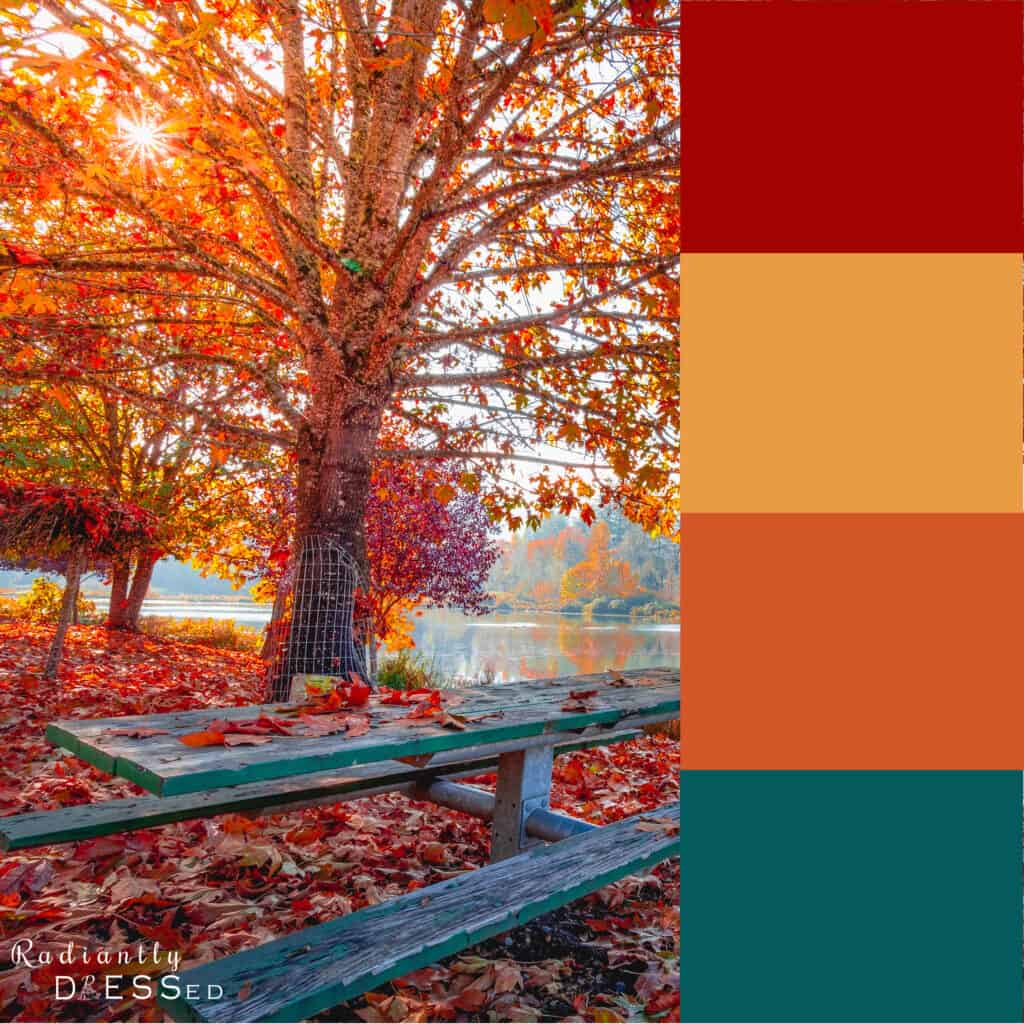
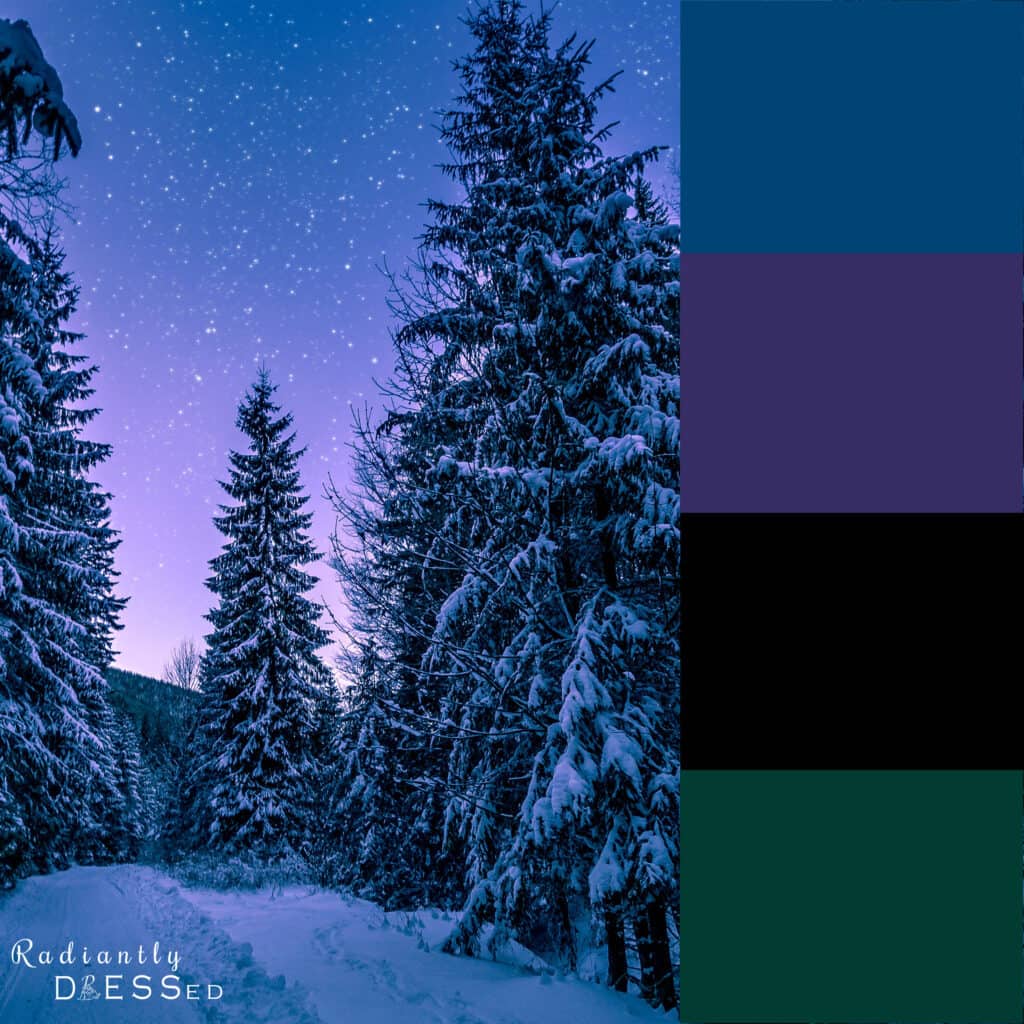
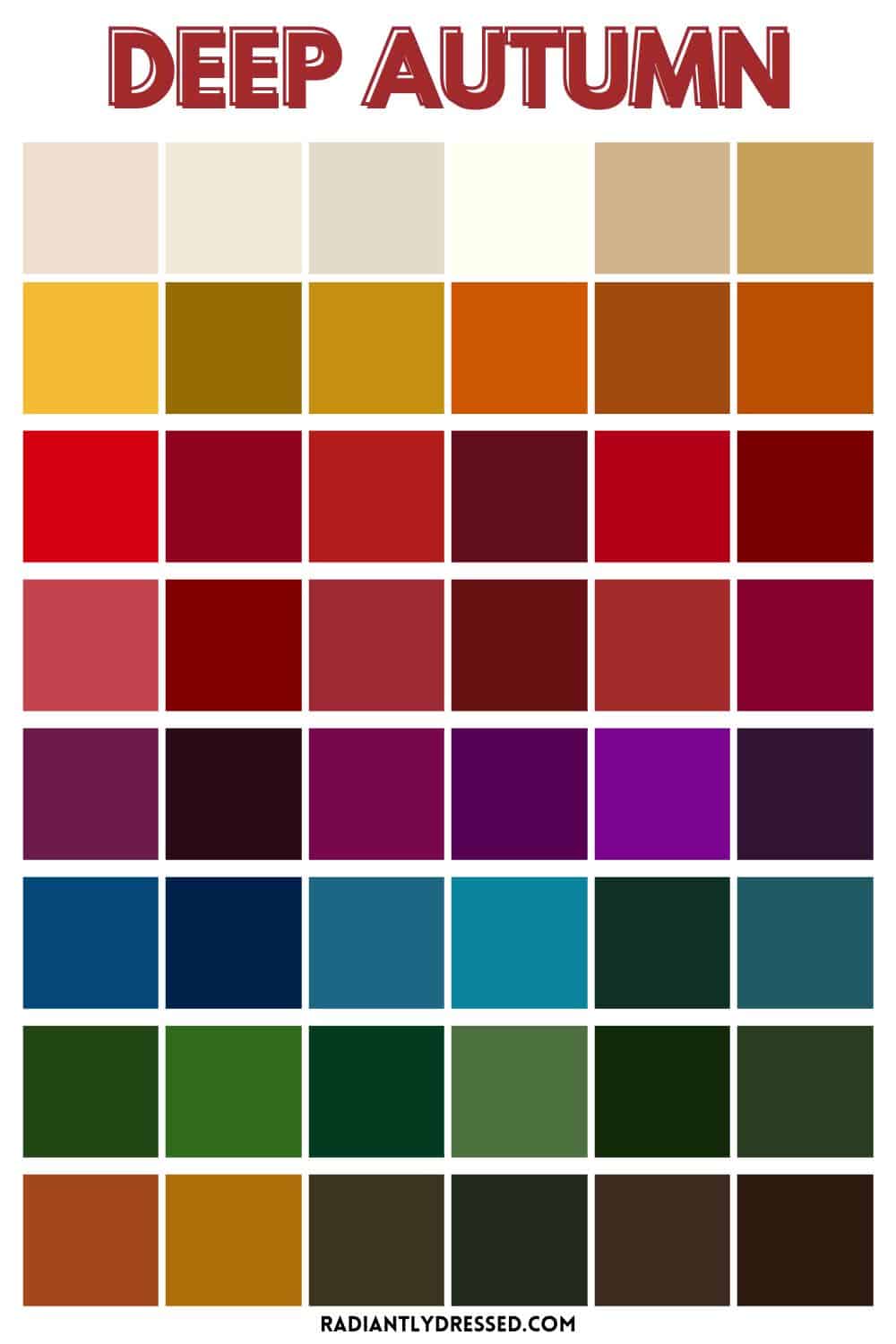
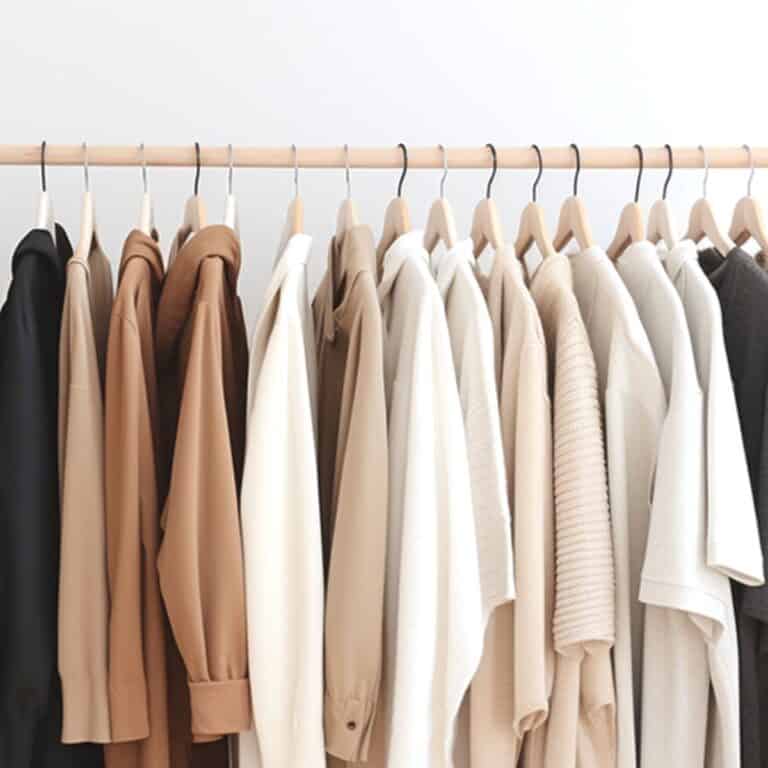
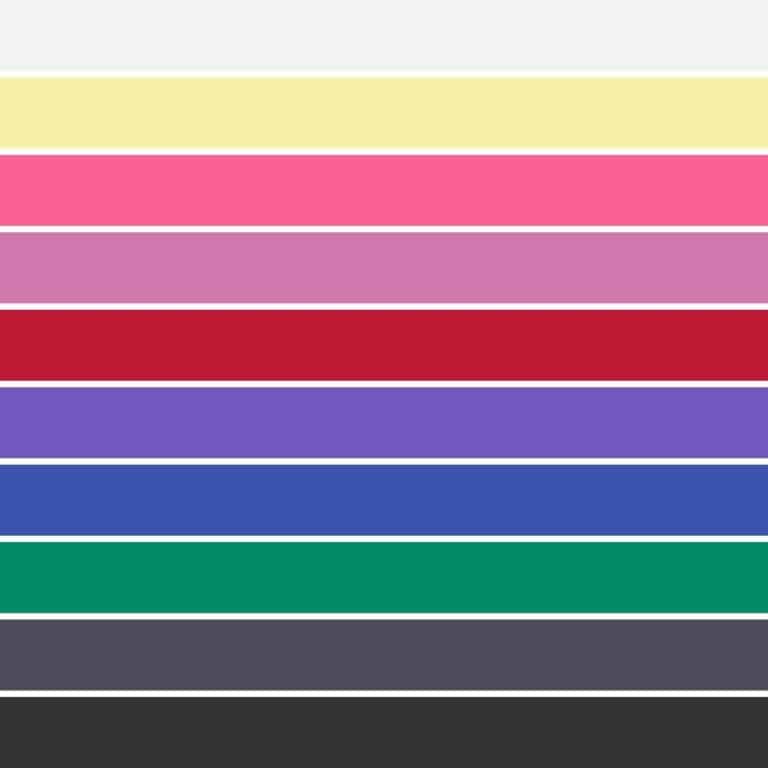
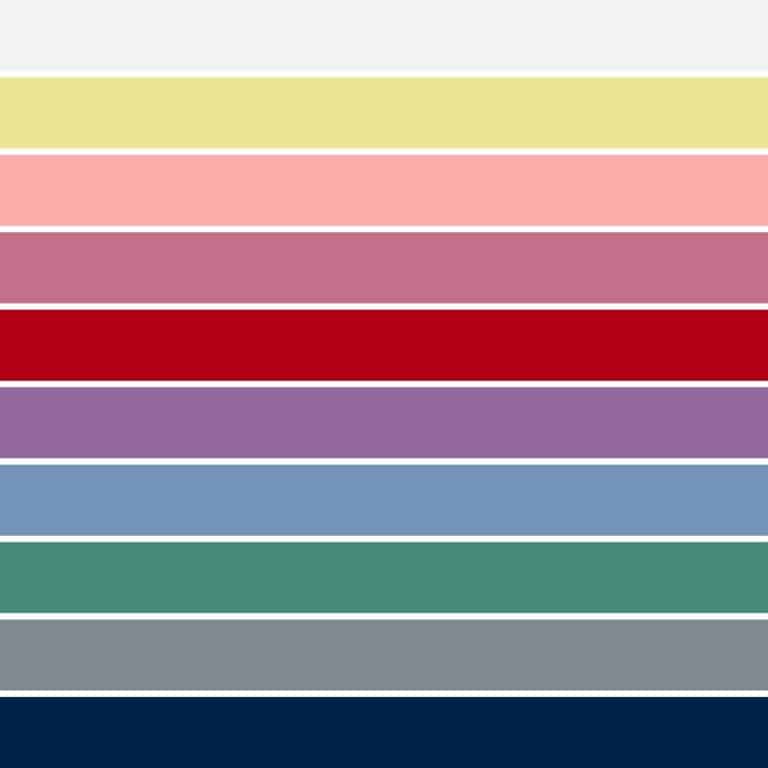
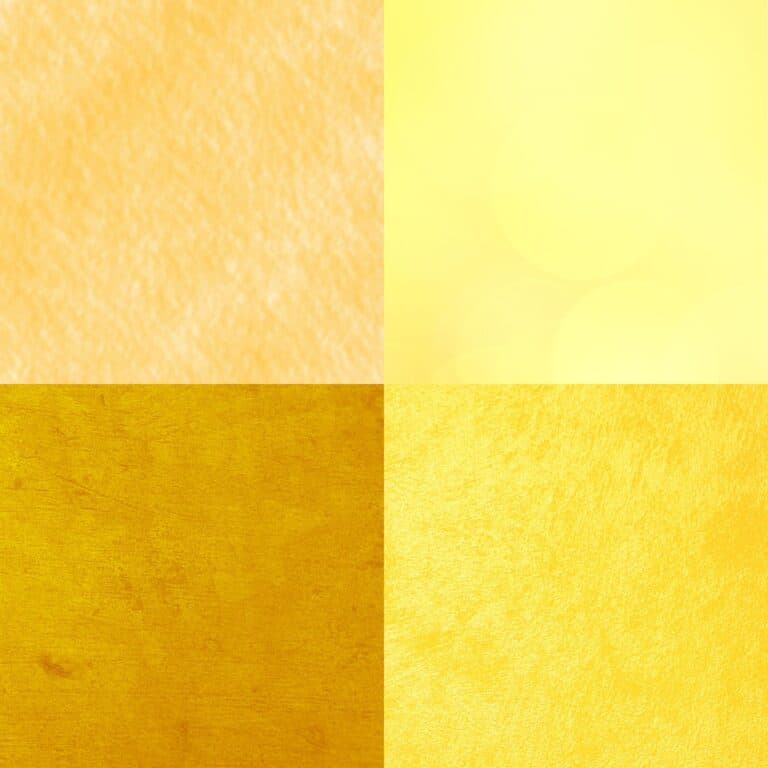
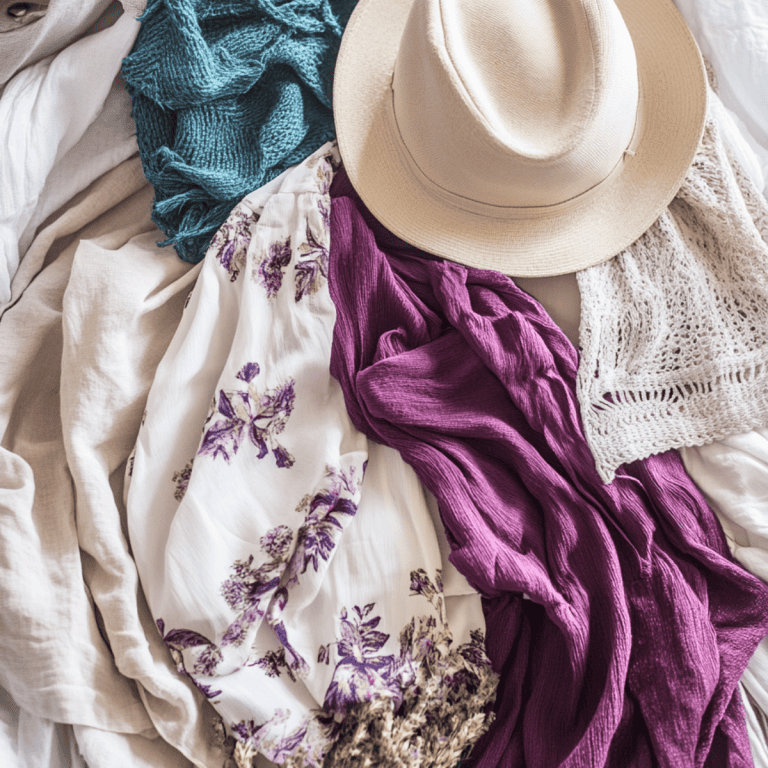
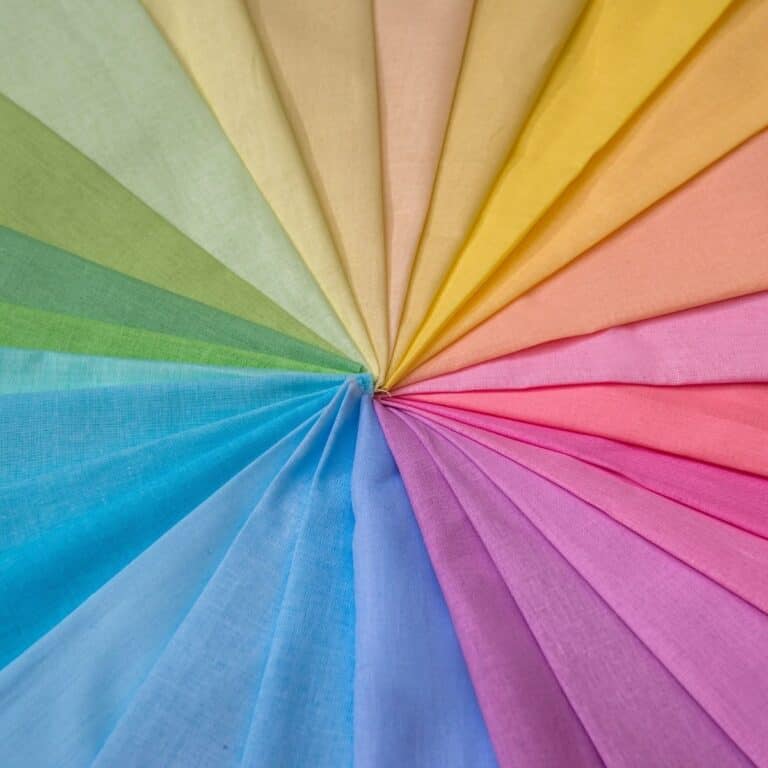
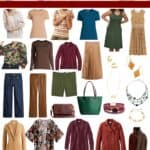



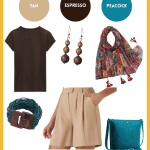
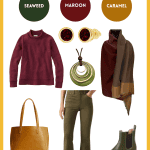
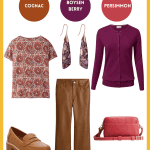
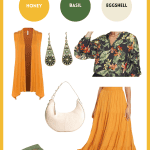
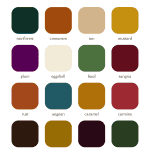
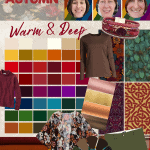
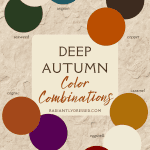
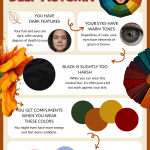
I had my colours done 22 years ago and am fascinated by colour theory and analysis but have to say it can be confusing at times . Have to say this is by far the best article I have ever read on deep autumn . Thank-you x
Wow Dee that’s an amazing compliment. Thank you so much! I’m so happy it was useful for you!
Exactly..
I am sixty-four years old and had my colors “done” way back in the eighties. My daughter, a deep winter, suggested I might be a deep autumn. And, I am. I have always loved and looked great in olive green and finally it makes sense. I look forward to buying new makeup colors and finally giving away that cool candy pink top I always hated. Now I know why.
This is a great article. The list of worst colors clinched it.
I feel a bit silly being mistaken for so long but I am ready to embrace my true colors.
Thank you!
Amy
Hey Amy! I’m glad you finally found a perfect fit! There is a lot of overlap between the deep winter and autumn seasons, and so confusion is completely normal!
Hello Stacey I’m also 64 years old and had my colours done a long time ago and I’m deep Autumn I love the colours but wondered if you could suggest a capsule wardrobe for deep Autumn thank you Gai
Hey Gail! If you’re looking for a capsule wardrobe palette, there are 12 additional options in the Deep Autumn seasonal guide! If you want to build your own, I suggest choosing a signature color that looks best on you from the palette, and adding 4-6 coordinating colors! I just did a post on best neutral colors for each season as well!
a capsule wardrobe for dark autumn which includes some suggestions on bottom and top combination and shoes and accessories like bag and hair ….that will be so awesome….i have a overloaded wardrobe but none suits….so i m now doing all i can to create a capsule…self assessed to dark autumn
The recent update includes a capsule wardrobe with bags, shoes, and accessories.
Thank you for this post! I was trying to find out what colour clothes and makeup i should buy on my next shopping spree and this is very helpful! I always knew i looked fabulous in yellow and vinotinto (wine colour).
Much love x
I self proclaimed that I am warm/deep autum. I started building a capsule wardrobe. This article covers a lot and gave me a broader perspective on what to add to my wardrobe. Thanks
I had my colours done over ten years ago and was told I was a “Snow White” or cool Winter, however on the past year or so I have realised that I’m actually more neutral than cool toned and believe I am a deep Autumn. I’ve started wearing Autumn colours, which I had previously avoided (such as chocolate and olive) and have been amazed at how good they look on me. Your website and this article has confirmed to me that I am actually an Autumn and I’m a little frustrated that I’ve spent so many years avoiding colours that really suit me!
Hi Maria!
That’s quite interesting! I’m glad you found colors that feel more in tune with who you are!!1
You are very thorough. I read you, screenshotted you & took note of you. Thank you for a very comprehensive explanation. I am cleaning my closet now. The funny part though is that all the color pallete for deep autumn has always been my favorites. The color theory fully explains why some colors I pick just don’t look good on me—another wasted money. I love you. You’re an amazing teacher.
Lorda!!!
What an amazing compliment, thank you so much! The right colors make a huge difference and cleaning out closets has never been easier when you can identify the “not good” colors! Thanks for being here!
I’ve been really confused about exactly this – am I a deep autumn or a deep winter?! And now I’m sure, absolutely deep autumn! Thank you, thank you, thank you! This article was exactly what I needed, so very good written with loads of knowledge! The best I’ve read on this topic! Now I feel sure about what (colors) to look for when shopping for new clothes.
Elin, thank you!!!! There’s a really fine distinction between deep autumn and deep winter and loads of people get stuck here! I’m glad this helped you figure it out! Happy you’re here!
Hi! All the surface criteria say I’m a deep autumn but I feel more like a warm autumn person. But no worries, I love the color palette. I’m 20, and just starting out towards building a wardrobe that would work for me for the years to come. Your article was very very helpful, I read it thoroughly and I appreciate your effort. Thank you.
Hey Kritika!
Thanks for the feedback! An autumn can theoretically wear the entire range from soft through deep. Deep Autumn typically has some cool crossover whereas a Warm Autumn will have warmth in all the features!
This is the best, clearest, and most comprehensive article on color theory I have ever read! Thank you. I am one of those Deep Autums who can sneak in periwinkle.
Thank you so enjoyed reading the analysis so true for me I’m actually grey havnt coloured my hair for ages and still these colours for deep autumn are still a great choice
Look forward to pics of combo outfits suitable to my colours happy day thanks Pearl
This is the best article I came across about deep autumn. I am 42 years old living in NYC. Most of my wardrobe is black, grey and white :/
I have learnt about this theory a year ago trying to find best color to wear at the wedding party and my skin was glowing like never before when I picked the boysenberry for the event. So now I’m more conscious what to buy and am building up my deep autumn wardrobe. Thank you so much 🙂
Thanks so much for the great feedback! Glad you found a stunner color for such an important event!
Thanks for this info, I had been trying to figured out my season for years…but every test I did there was always someting out.
I have dark brown hair with a red undertone, my eyes are dark brown…again there is some red in them, my skin is white with a yellow undertone, that my family used to called “the fake hepatitis”, because in the city I used to look very pale in winter and people used to thought I got it. Now I live in the mountains and wanted or not I’m always tanned. I’ll try to follow this tips but I had always thought earth we not my colors and yellows will bring that yellow sikcness tone on my face. Quite scared, but I’m tired of looking washed out and plain. ????
Hey Romina,
If you have white skin with yellow that could be a manifestation of olive skin, in which case winter is almost definitely a better choice!
I’ve enjoyed reading your blog on color analysis ad have learned a lot. I am still confused about one thing — years ago, when my hair was still brown my “season” was determined to be deep autumn bordering on deep winter, and those colors worked very well for me. So did the colors you’ve classified as true/warm autumn. They still work well for me even though my hair is now rooted dark blonde. I would have thought lightening my hair would necessitate a change in my wardrobe’s color palette, but it hasn’t.
This was the most concise, comprehensive, and educational article I’ve ever read on Deep Autumn. It answered so many questions I’ve had. And the idea of sister seasons was inspired!!! I’m a little of both Deep Autumn and Deep Winter, so I’m vacillating between the two. Seriously, thank you for this obvious labor of love. My favorite is the part where you put the deep autumn colors into the other seasons. Absolutely sensational. I’ve already sent my friends their corresponding color articles.
Thank you so much!!!! I’m so glad it was helpful!
Hello, I am constantly stuck between dark autumn and dark winter. What are colors I can try so it shows me I am one or the other. I am African American, more leaning towards the lighter complexion side (vague I know). Dark brown almost black eye and dark brown natural hair color. Thanks. I will also happily do a consult because I struggle to shop for myself now. Thanks again
Hey Keonda,
Light complexion makes me suspect that you might also consider clear winter/spring if you have higher contrast. As far as the definitive between those two, I would check a warm orange-rust versus a blue based magenta. A true dark cobalt would also say winter more than autumn. Hope that helps, and happy to do an analysis for you if you choose!
Really interesting article. I am mostly a deep autumn: very dark brown hair with red/ golden highlights in the sun, hazel eyes but I’m relatively pale unless I get a lot of sun during the summer so I do have a lot of contrast between my dark hair and skin. That’s where I get a bit confused and think I toe the line between deep autumn and winter. I definitely gravitate toward autumn colors like pumpkin, rust, olive green, etc BUT I love wearing (and find it flattering) my basic bright white T shirts which is considered a no no for a true deep autumn so can I be both? Winter and autumn?
Hey Rachel
I find this pretty common actually, lots of deep autumns really like a bright white. I would suspect that you are more neutral-warm versus neutral-cool based on the colors you like, but always wear what you love.
Thank you for your article! I am struggling with colour as I age but after reading your article I believe I am a dark autumn. I have fair skin that freckles. Dark brown almost chocolate eyes and black hair that now has lots of silver. When I was young I had very rich dark brown hair with warm highlights. But since my grey has started coming in my hair looks black and no more highlights. Unless you count the silver. I struggled between knowing if I was autumn or winter but dark brown is probably my best colour. Where I am struggling is the silver and black hair. Can a dark autumn go silver? And still be a dark autumn? I am working on rebuilding my wardrobe with better colours for me. Thank you for your help!
Hi Colleen! Absolutely it can be silver! You may find that silver and black increases you contrast so you can wear some of the brighter colors in warm autumn.
Thank you so much for responding! Your article is so informative. It’s my favourite that I keep coming back to. I have read other suggestions about holding different colours up to your face and taking a picture to compare. Would you suggest doing that in a window area where there is natural light? I admit I still struggle to see which colours work better . Part of the problem is I’m so pale but I definitely have a yellow undertone but can also look red in some areas. If it is possible to send you a picture let me know. I would love to nail this down so I buy the best colours moving forward!
This is very helpful information. My eyes are brown and olive green and my natural hair color is a light brown with warm streaks. My skin is very fair and undertone is difficult to choose.
I was typed (twice!) as a winter, but both were puzzled by how soft I needed the colors to be. But they said I had to be a winter because I could carry black and navy. One did give me a dark dusty teal as my navy.
Then someone else said she thought I was actually an autumn instead and it all clicked. Reading your information here I can understand how I was mistyped and see that I’m actually a deep autumn. Thank you!
So beautiful 🙂
Love this page. I have it bookmarked and keep coming back to it. Thank you!!
Hi ! Great article, very complete and a lot of very cool images. But I don’t know, color theories kind of made me unconfortable. I have deep, almost dark eyes that people usually say are scary because really dark, but it lighten up in the sun, long dark brown hair that turn to red/auburn in the sun and a yellow/red undertone skin that used to be really darker that it is now, it’s quit epale now, but I really looked like indian or amerindian growing up. I believe I belong to deep autumn, however, as long as I love kaki, canard blue, and all kind of brown, I always feel like I belong to rich, bright, indian colors. I feel like turquoise blue, fuschia pink, yellow, bright red really suit me. Especially turquoise blue, and I look great with any shade of yellow, bright, intense, indian sun yellow being the best, but people always told me my pastel yellow sweater and free people magnolia light yellow dress both look good on me, they react easily to me wearing those colors, and I personally feel very very good in peach too. I feel like too dark red, as long as I love it, can easily ” unlit ” me, in opposition to bright, “true”, fairy tall or typical vintage red. I believe I wear a lot of spring color palette, in fact, and I really think that really suit me. My wardrobe looks like a rainbow, and sometimes, it come close to a sunset. I don’t know ? Most of indian woman could be identify as deep autumn and, as me, they look way better in bright and intense, sunfull colors. I don’t say I don’t like the deep autumn palette but, clearly, that’s not the main focus on my wardrobe. I do really like green, however. Kaki, yes, but also brighter green, all type of green, as I really love nature.
I would love to see a post on how to work with dark autumn colors after one goes white/silver or gray. At 65, my hair is now a creamy white and I’m having a very difficult time landing on colors that work for me.
I know that I am a deep autumn, I have been personally draped three times and always come out as deep autumn, but my colouring is changing a bit with age. I am dyeing my hair a slightly lighter mid gold brown and my eyes have gone from darkest olive green to brighter, lighter olive green. The brown has gone from them and been replaced by grey spots. I have been redraped three times and come out as three different groups, which is totally confusing. Soft autumn, bright spring and warm spring. My skin has always been very light ivory, very neutral, not golden as often with dark autumns, so I have never looked good in the autumn mustards, camels and browns. I have gone slightly sharper with leopard brights mixing very light ivory tones with black and browns, deep greens and slightly warm, dark red shades. Now my hair is necessarily a bit lighter than darkest brown, I am totally confused as to if I am deep autumn still or not, and if not, what am I?Any help would be most welcome.
Hey Trisha,
If you’re suiting brighter rich warm tones you might need to start dressing in the Warm Autumn colors. As a three time confirmed autumn you shouldn’t leave that overall big 4 season.
Stacey